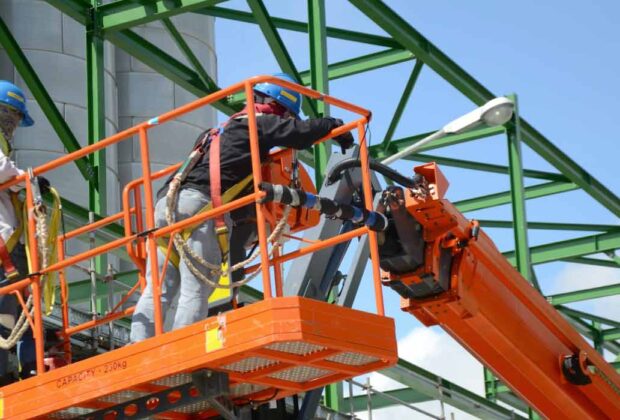Asbestos has long been used to increase strength and to make products longer lasting and fire-resistant. This wide spread use means the dangers of asbestos may be present anywhere from your home to your workplace.
Inhaling asbestos fibres can seriously aggravate your lung tissues, leading to scarring and a greater increase in risk for diseases such as cancer and asbestosis.
Although asbestos has been heavily regulated in recent years, it is still used in a number of products. The dangers of asbestos are present to workers across a number of industries in Canada.
If you work in an industry where you may be exposed to asbestos, or your home was built prior to 1990, Asbestos Awareness Online Training through Danatec by We Know Training will teach you proper safety, and the potential hazards when dealing with asbestos in its various forms.

What is Asbestos?
Asbestos occurs naturally across the world. It is not a single mineral – rather, it refers to a group of silicate minerals which all share the same fibrous nature.
Deposits of asbestos have been found across the world – and the mineral was once widely mined in Canada. The main exporters of asbestos are Russia, Kazakhstan and China.
There are six forms of asbestos which are separated into two categories – amphibole asbestos and serpentine asbestos.
Amphibole asbestos type(s):
- Crocidolite
- Amosite
- Anthophyllite
- Tremolite
- Actinolite
Serpentine asbestos type(s):
- Chrysotile
There are other asbestiform minerals which exist naturally in nature which may be just as dangerous as the six legally recognized forms of asbestos including winchite and richterite.

Where and Why Was Asbestos Used
Asbestos was thought of as a “miracle-mineral” because of its heat resistance and strength, leading to it being widely used in a variety of industries and products.
To be used in commercial products, raw asbestos ore is crushed to separate out other minerals. The asbestos is then processed until only a soft, wool-like consistency remains.
Asbestos fibres are extremely resistant to heat, electricity and corrosion, but are also extremely soft and flexible. However, these fibres can be microscopic in size and are easily inhaled.
Pure asbestos can be used in cloth, paper. Cement, plastic and a number of other materials to increase the products strength.
Products
A number of common items used in the construction of your home or work may have been made using asbestos, including:
- Corrugate wall and roof sheeting
- Roof Guttering
- Ridge Capping
- Imitation Brick Cladding
- Window Glazing
- Roof Insulation
- Base Flashing
- Felt
- Shingles
- Tar
- Cloth Wire Insulation
- Decorative PlasterCaulking
- Spackling Compounds
- Vinyl Wall Coverings
- Wallboard Sheet Rock
- Asphalt Floor Tiles
- Carpet Mastic
- Floor Tile Mastic
- Vapor barrier
- Linoleum Sheet Flooring
- Duct Work Insulation
Asbestos has also been used in a wide range of consumer items such as appliances and automotive products including items such as:
- Hair Dryers
- Coffee pots
- Toasters
- Irons
- Crock Pots
- Brake Pads
- Duct Tape
- Talc products such as baby powder
- Chalkboards
- Wood-Burning Stoves
- Fireproof Gloves
Canada’s first asbestos mine was in Quebec and began operations in 1879. Large deposits of the mineral were found across Quebec, Newfoundland, British Columbia and the Yukon.
The last operating asbestos mine in Canada was closed in 2011. Surprisingly, strict regulations against asbestos weren’t enacted in Canada until 2018.
By 1966 approximately 40 percent of the world’s chrysotile asbestos was produced in Canada. Because of this, by the 1970s doctors had declared the asbestos mining towns in Canada to be among the most dangerous in the world.
Asbestos is still permitted to be used in a very small number of products throughout Canada, but its use is heavily regulated.

Health Risks and Dangers of Asbestos Exposure
The dangers of asbestos rise greatly when a product is agitated. When materials that contain asbestos are disturbed, they release microscopic fibres into the air, which when inhaled cause damage to lung tissue.
Often diseases caused by asbestos take years or even decades to develop and show symptoms. Once a patient is diagnosed, however; it is often too late to treat the disease.
The most common asbestos related diseases are:
- Mesothelioma – A cancer affecting the lining of the lungs and the lining of the lower digestive tract. Mesothelioma is almost always exclusively related to asbestos exposure and by the time of the diagnosis is almost always fatal.
- Lung cancer – Asbestos related lung cancer is almost identical to lung cancer caused by smoking or other related causes.
- Asbestosis – A scarring condition of the lung that normally occurs after large amounts of exposure to asbestos over many years. Asbestosis causes shortness of breath and in some cases can be fatal.
Statistics
According to Statistics Canada, between 2000 and 2016 the number of Canadians dying from mesothelioma rose from 291 deaths in 2000 to 510 in 2016 – marking an almost 70 percent increase.
In addition to mesothelioma, asbestos causes more than twice as many cases of lung and other cancers, as well as asbestosis.
Asbestos-related diseases are the leading cause of work-related deaths in Saskatchewan, accounting for 42 percent of all work-related deaths which were reported to WCB in 2018.
Workers across a wide range of occupations may be at risk of exposure to asbestos, those positions include but are not limited to:
- Mining of asbestos occurring from natural mineral deposits
- Processing of asbestos minerals (millers)
- Manufacture of asbestos-containing products
- Construction industry – disturbing asbestos-containing materials during building renovations or demolitions
- Mechanics – vehicle brake and clutch repairs
- Marinas – renovating or demolishing ships constructed with asbestos-containing materials
- Insulation workers and heating trades
- Sheet metal workers, plumbers and pipe fitters
- Workers responsible for disposing of asbestos waste, and waste workers
- Cement workers
- Custodial workers – contact with deteriorating asbestos-containing materials in buildings
The World Health Organization has declared all forms of asbestos carcinogenic and recommends its use be eliminated.
Asbestos exposure is responsible for more than a third of total workplace death claims made since 1996, according to the Globe and Mail. In 2013 more than 300 death claims were made stemming from asbestos exposure – representing a higher number than fatalities from highway accidents, fires and chemical exposures combined.
Due to heavy usage in past years, many Canadians may have been exposed to asbestos and may not know it. Danatec by Yardstick training provides industry leading training courses to protect you, your employees, or your loved ones from asbestos exposure.




Comments are closed.